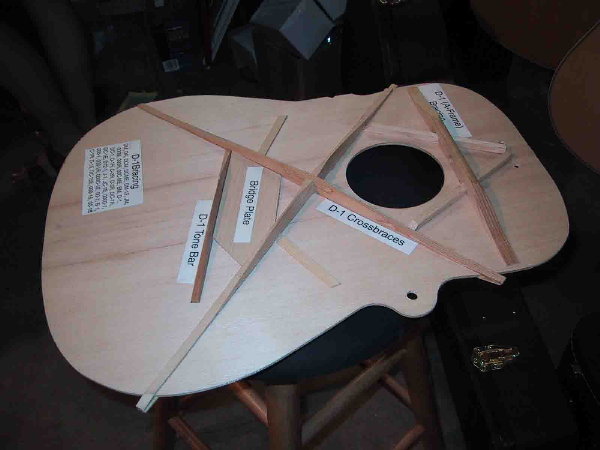
Braces and Bridgeplates
Some of the most common questions I get are: "What is scalloped bracing?" and "What is the 'popsicle brace'?". The latter is more correctly called the "top plate". These photos were taken at Winfield 2000. Thanks to the CF Martin Co for the models, Mass. Street Music for letting me monopolize their booth for a few minutes, and to Lew Portnoy for taking the shots. This page is in no way associated with any of those companies/individuals, and all trademarks used are theirs.
Non-Scalloped bracing:
Lets's start with standard non-scalloped bracing such as found in the D-28. Notice that the tone bars are straight on top. Compare this to the scalloped bracing below. Also, take a look at the bridge plate. This is a nice-sized, not too small, not too large, maple bridge plate.

Scalloped bracing:
Compare the tone bars above to the tone bars on this scalloped top. HD-28's use this top. Notice the distinct dip in the middle of the brace. This weakens the top, but also provides increased bass and response. The main-X brace and side tone bars are also scalloped.

A-frame bracing:
One of Martins' newer innovations is the "A-frame bracing". Notice the area to the right of the soundhole- see how the bracing comes to a point? That's the A-frame. Also notice the lack of a top plate brace. This top is non-scalloped, but is tapered instead- notice how the braces taper off toward the ends. Notice also the lack of a brace on the left hand side of the top.

Hybrid A-frame bracing:
This is what Martin calls a "hybrid" bracing. It has the additional tone bar to the left, and the other tone bar has been moved down (compare the bridge plate in both shots), which is what the "regular" bracing uses, but the A-frame is still present at the right of the soundhole.

And here's the (in)famous top plate brace (AKA popsicle, transverse, tongue-depressor brace)! The neck block would sit just north of the top plate in this shot.

Inside a D-1:
Here's the interior of a Martin D-1R. Notice the A-frame bracing, lack of a top plate, and laminated headblock. A lot of discussion has been made as to whether these can be reset or not. Guess we'll find out, but it seems to me that one could clamp the block together from the inside before applying any steam or heat. Personally, I find D-1's to have a very nice, bright, loud sound, and I suspect that the A-frame and lack of top plate have a lot to do with this.

Back to Music page